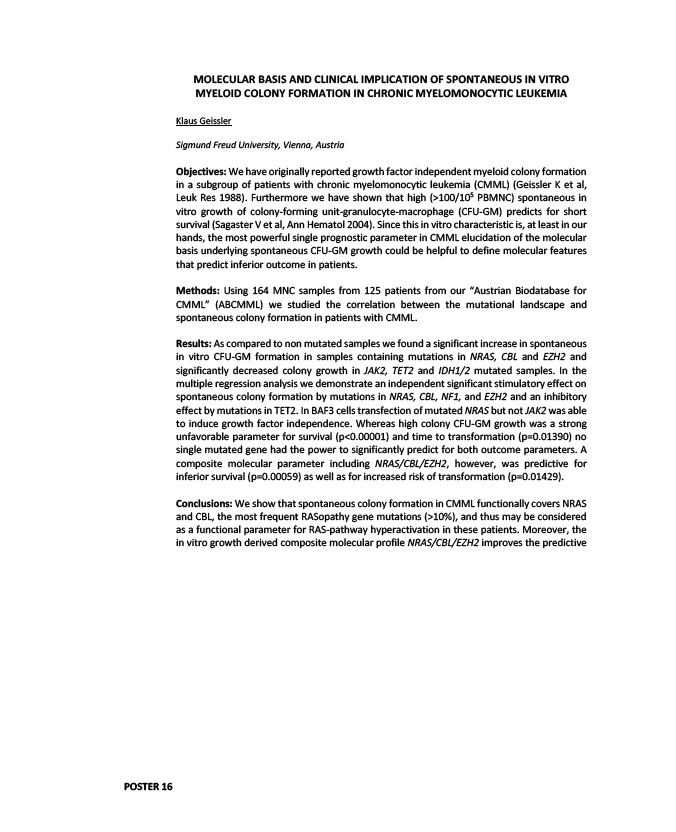
MOLECULAR BASIS AND CLINICAL IMPLICATION OF SPONTANEOUS IN VITRO
MYELOID COLONY FORMATION IN CHRONIC MYELOMONOCYTIC LEUKEMIA
Klaus Geissler
Sigmund Freud University, Vienna, Austria
Objectives: We have originally reported growth factor independent myeloid colony formation
in a subgroup of patients with chronic myelomonocytic leukemia (CMML) (Geissler K et al,
Leuk Res 1988). Furthermore we have shown that high (>100/105 PBMNC) spontaneous in
vitro growth of colony-forming unit-granulocyte-macrophage (CFU-GM) predicts for short
survival (Sagaster V et al, Ann Hematol 2004). Since this in vitro characteristic is, at least in our
hands, the most powerful single prognostic parameter in CMML elucidation of the molecular
basis underlying spontaneous CFU-GM growth could be helpful to define molecular features
that predict inferior outcome in patients.
Methods: Using 164 MNC samples from 125 patients from our “Austrian Biodatabase for
CMML” (ABCMML) we studied the correlation between the mutational landscape and
spontaneous colony formation in patients with CMML.
Results: As compared to non mutated samples we found a significant increase in spontaneous
in vitro CFU-GM formation in samples containing mutations in NRAS, CBL and EZH2 and
significantly decreased colony growth in JAK2, TET2 and IDH1/2 mutated samples. In the
multiple regression analysis we demonstrate an independent significant stimulatory effect on
spontaneous colony formation by mutations in NRAS, CBL, NF1, and EZH2 and an inhibitory
effect by mutations in TET2. In BAF3 cells transfection of mutated NRAS but not JAK2 was able
to induce growth factor independence. Whereas high colony CFU-GM growth was a strong
unfavorable parameter for survival (p<0.00001) and time to transformation (p=0.01390) no
single mutated gene had the power to significantly predict for both outcome parameters. A
composite molecular parameter including NRAS/CBL/EZH2, however, was predictive for
inferior survival (p=0.00059) as well as for increased risk of transformation (p=0.01429).
Conclusions: We show that spontaneous colony formation in CMML functionally covers NRAS
and CBL, the most frequent RASopathy gene mutations (>10%), and thus may be considered
as a functional parameter for RAS-pathway hyperactivation in these patients. Moreover, the
in vitro growth derived composite molecular profile NRAS/CBL/EZH2 improves the predictive
POSTER 16